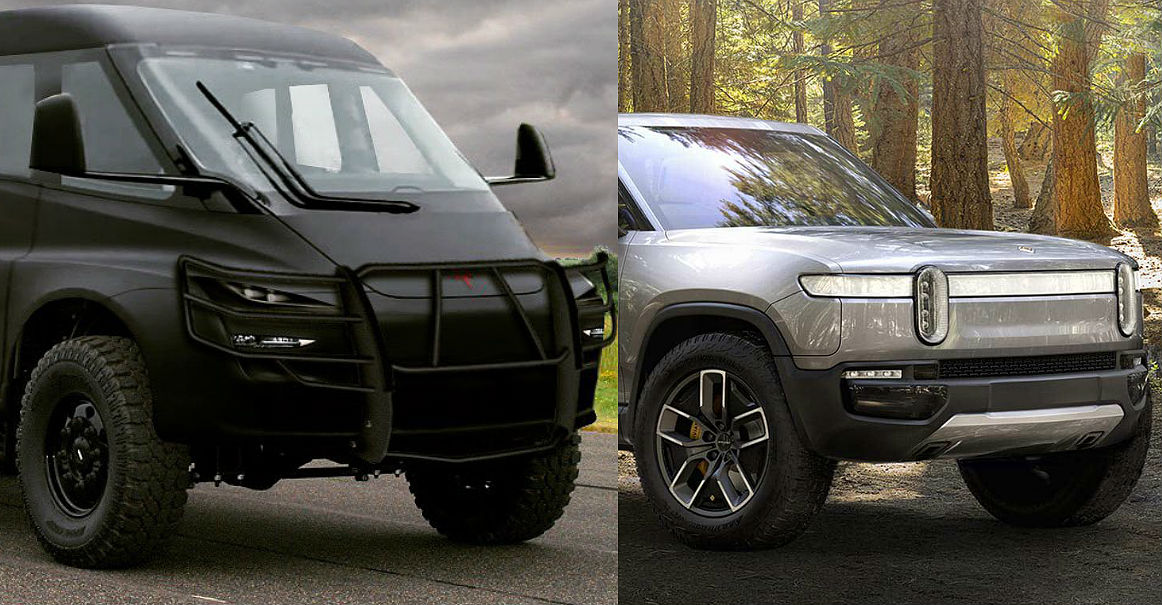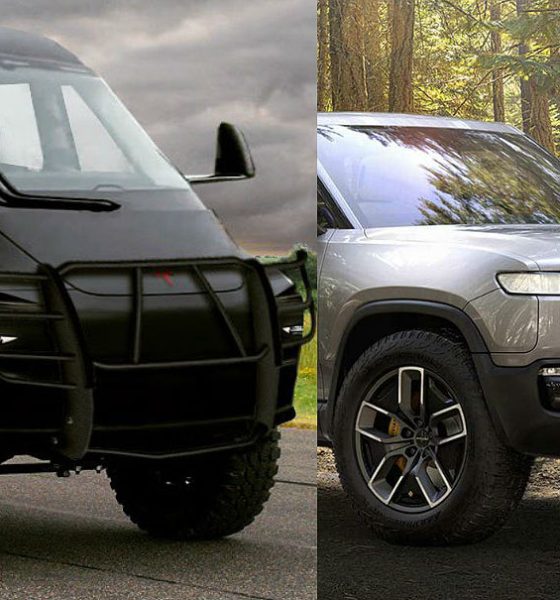

News
Tesla’s pickup truck and Rivian’s R1T can topple the mighty Ford F-150
The mighty Ford F-150 might see a legitimate challenge in the near future, if the veteran automaker neglects to prepare adequately for the arrival of two all-electric pickup trucks on the market — the Tesla Truck and the Rivian R1T.
The disruption of battery-powered pickup trucks was highlighted in a note from Morgan Stanley analyst Adam Jonas on Thursday. Addressing the firm’s investors, the analyst stated that an electric pickup successfully launched by a new player like Tesla or Rivian “could be a serious problem for the Detroit-based traditional automakers.” With the arrival of compelling vehicles, Jonas noted that experienced carmakers like Ford could lose the opportunity to gain a “first mover advantage” in the electric pickup market.
Promising Challengers

The Wall St analyst’s points hit the nail on the head, considering that the innate characteristics of electric vehicles such as instant torque and generous towing capacity are factors that are vital to the pickup truck market. The Rivian R1T, for example, is listed with a towing capacity of 11,000 pounds, though CEO RJ Scaringe noted in a recent interview that the truck could tow far beyond its official rating. Thanks to the R1T’s four electric motors, the truck is also able to hit 60 mph in just 3 seconds.
The Tesla Truck, on the other hand, has been mentioned several times by Elon Musk in recent months. Last year, Musk held a Twitter brainstorming session with his social media followers to list down features that are important for pickup truck owners. By the end of the session, Musk noted that the Tesla Truck would have two electric motors and dynamic suspension, a range of 400-500 miles per charge, four-wheel steering, a 240-volt connection for heavy-duty tools, and even an air compressor to run other equipment. Musk also noted that the vehicle could tow as much as 300,000 pounds.
Tesla’s Acid Test

Anyone skeptical of the potential disruption from an electric vehicle does not need to look very far. Over the past year, Tesla’s Model 3 midsize sedan all but shook the United States’ passenger car market, creeping up on ubiquitous vehicles like the Toyota Camry and dominating in revenue rankings. By the end of 2018, the Model 3 was the US’ best-selling luxury vehicle, despite being a sedan in a market that prefers SUVs and pickup trucks.
With a battery-powered pickup truck that is reasonably priced and well-equipped with features, carmakers such as Tesla and Rivian could challenge even the US auto industry’s biggest sellers, including the Ford F-150. One thing that would be a hindrance to this potential disruption, of course, would be the capability of electric car makers to scale production, especially considering the demand for pickups in the US. In this light, Rivian must still prove itself, since the production of the R1T is yet to begin. Tesla, on the other hand, is already learning the art of mass production, as shown by its growing pains with the Model 3 ramp.
A Way to Maintain the Status Quo

Despite the upcoming challenge and Wall Street’s recent warning, Ford does have a way to maintain the status quo in the pickup truck market. Last month, Jim Farley, Ford’s president of global markets, announced that the F-series would be going electric. Farley later added that the decision to adopt all-electric and hybrid power is a way to “future-proof” the company’s most successful vehicle line.
If recent sightings are any indication, it appears that Ford is at least testing an electric prototype of the F-150. As noted in a recent sighting, a camouflaged electric F-150 has been spotted charging at a station. The vehicle looked a lot like a regular truck, save for its charging port and its higher ride height, which appeared to be the result of batteries installed underneath the vehicle. Provided that Ford does not show some ill-timed hubris by giving the electric F-150 mediocre specs and range, the company could very well weather the storm of electric trucks coming its way.

Elon Musk
Elon Musk and Tesla AI Director share insights after empty driver seat Robotaxi rides
The executives’ unoccupied tests hint at the rapid progress of Tesla’s unsupervised Robotaxi efforts.

Tesla CEO Elon Musk and AI Director Ashok Elluswamy celebrated Christmas Eve by sharing personal experiences with Robotaxi vehicles that had no safety monitor or occupant in the driver’s seat. Musk described the system’s “perfect driving” around Austin, while Elluswamy posted video from the back seat, calling it “an amazing experience.”
The executives’ unoccupied tests hint at the rapid progress of Tesla’s unsupervised Robotaxi efforts.
Elon and Ashok’s firsthand Robotaxi insights
Prior to Musk and the Tesla AI Director’s posts, sightings of unmanned Teslas navigating public roads were widely shared on social media. One such vehicle was spotted in Austin, Texas, which Elon Musk acknowleged by stating that “Testing is underway with no occupants in the car.”
Based on his Christmas Eve post, Musk seemed to have tested an unmanned Tesla himself. “A Tesla with no safety monitor in the car and me sitting in the passenger seat took me all around Austin on Sunday with perfect driving,” Musk wrote in his post.
Elluswamy responded with a 2-minute video showing himself in the rear of an unmanned Tesla. The video featured the vehicle’s empty front seats, as well as its smooth handling through real-world traffic. He captioned his video with the words, “It’s an amazing experience!”
Towards Unsupervised operations
During an xAI Hackathon earlier this month, Elon Musk mentioned that Tesla owed be removing Safety Monitors from its Robotaxis in Austin in just three weeks. “Unsupervised is pretty much solved at this point. So there will be Tesla Robotaxis operating in Austin with no one in them. Not even anyone in the passenger seat in about three weeks,” he said. Musk echoed similar estimates at the 2025 Annual Shareholder Meeting and the Q3 2025 earnings call.
Considering the insights that were posted Musk and Elluswamy, it does appear that Tesla is working hard towards operating its Robotaxis with no safety monitors. This is quite impressive considering that the service was launched just earlier this year.
Elon Musk
Starlink passes 9 million active customers just weeks after hitting 8 million
The milestone highlights the accelerating growth of Starlink, which has now been adding over 20,000 new users per day.

SpaceX’s Starlink satellite internet service has continued its rapid global expansion, surpassing 9 million active customers just weeks after crossing the 8 million mark.
The milestone highlights the accelerating growth of Starlink, which has now been adding over 20,000 new users per day.
9 million customers
In a post on X, SpaceX stated that Starlink now serves over 9 million active users across 155 countries, territories, and markets. The company reached 8 million customers in early November, meaning it added roughly 1 million subscribers in under seven weeks, or about 21,275 new users on average per day.
“Starlink is connecting more than 9M active customers with high-speed internet across 155 countries, territories, and many other markets,” Starlink wrote in a post on its official X account. SpaceX President Gwynne Shotwell also celebrated the milestone on X. “A huge thank you to all of our customers and congrats to the Starlink team for such an incredible product,” she wrote.
That growth rate reflects both rising demand for broadband in underserved regions and Starlink’s expanding satellite constellation, which now includes more than 9,000 low-Earth-orbit satellites designed to deliver high-speed, low-latency internet worldwide.
Starlink’s momentum
Starlink’s momentum has been building up. SpaceX reported 4.6 million Starlink customers in December 2024, followed by 7 million by August 2025, and 8 million customers in November. Independent data also suggests Starlink usage is rising sharply, with Cloudflare reporting that global web traffic from Starlink users more than doubled in 2025, as noted in an Insider report.
Starlink’s momentum is increasingly tied to SpaceX’s broader financial outlook. Elon Musk has said the satellite network is “by far” the company’s largest revenue driver, and reports suggest SpaceX may be positioning itself for an initial public offering as soon as next year, with valuations estimated as high as $1.5 trillion. Musk has also suggested in the past that Starlink could have its own IPO in the future.
News
NVIDIA Director of Robotics: Tesla FSD v14 is the first AI to pass the “Physical Turing Test”
After testing FSD v14, Fan stated that his experience with FSD felt magical at first, but it soon started to feel like a routine.

NVIDIA Director of Robotics Jim Fan has praised Tesla’s Full Self-Driving (Supervised) v14 as the first AI to pass what he described as a “Physical Turing Test.”
After testing FSD v14, Fan stated that his experience with FSD felt magical at first, but it soon started to feel like a routine. And just like smartphones today, removing it now would “actively hurt.”
Jim Fan’s hands-on FSD v14 impressions
Fan, a leading researcher in embodied AI who is currently solving Physical AI at NVIDIA and spearheading the company’s Project GR00T initiative, noted that he actually was late to the Tesla game. He was, however, one of the first to try out FSD v14.
“I was very late to own a Tesla but among the earliest to try out FSD v14. It’s perhaps the first time I experience an AI that passes the Physical Turing Test: after a long day at work, you press a button, lay back, and couldn’t tell if a neural net or a human drove you home,” Fan wrote in a post on X.
Fan added: “Despite knowing exactly how robot learning works, I still find it magical watching the steering wheel turn by itself. First it feels surreal, next it becomes routine. Then, like the smartphone, taking it away actively hurts. This is how humanity gets rewired and glued to god-like technologies.”
The Physical Turing Test
The original Turing Test was conceived by Alan Turing in 1950, and it was aimed at determining if a machine could exhibit behavior that is equivalent to or indistinguishable from a human. By focusing on text-based conversations, the original Turing Test set a high bar for natural language processing and machine learning.
This test has been passed by today’s large language models. However, the capability to converse in a humanlike manner is a completely different challenge from performing real-world problem-solving or physical interactions. Thus, Fan introduced the Physical Turing Test, which challenges AI systems to demonstrate intelligence through physical actions.
Based on Fan’s comments, Tesla has demonstrated these intelligent physical actions with FSD v14. Elon Musk agreed with the NVIDIA executive, stating in a post on X that with FSD v14, “you can sense the sentience maturing.” Musk also praised Tesla AI, calling it the best “real-world AI” today.








